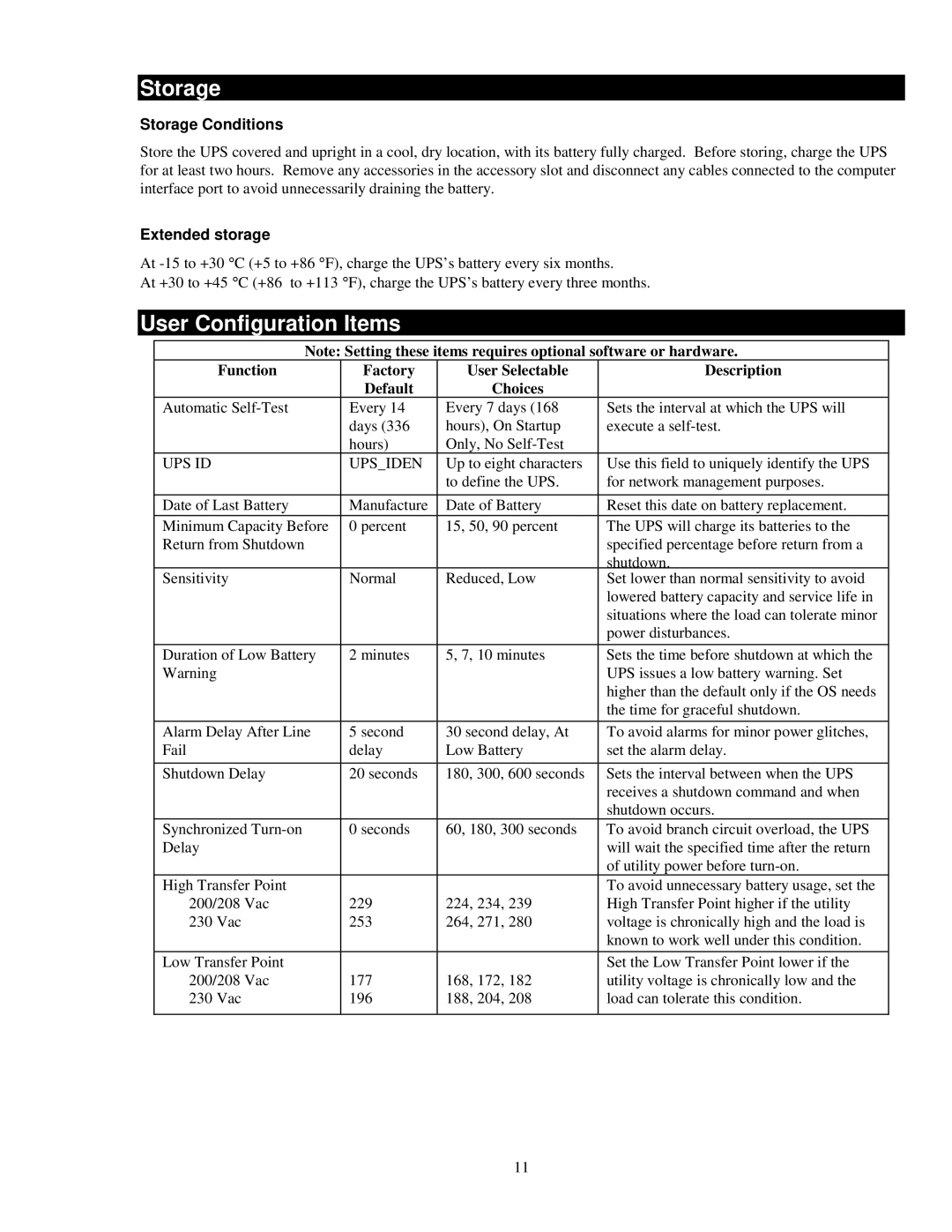
Storage
Storage Conditions
Store the UPS covered and upright in a cool, dry location, with its battery fully charged. Before storing, charge the UPS for at least two hours. Remove any accessories in the accessory slot and disconnect any cables connected to the computer interface port to avoid unnecessarily draining the battery.
Extended storage
At
At +30 to +45 ° C (+86 to +113 ° F), charge the UPS’s battery every three months.
User Configuration Items
Note: Setting these items requires optional software or hardware.
Function | Factory | User Selectable | Description | |
| Default | Choices |
| |
Automatic | Every 14 | Every 7 days (168 | Sets the interval at which the UPS will | |
| days (336 | hours), On Startup | execute a | |
| hours) | Only, No |
| |
UPS ID | UPS_IDEN | Up to eight characters | Use this field to uniquely identify the UPS | |
|
| to define the UPS. | for network management purposes. | |
|
|
|
| |
Date of Last Battery | Manufacture | Date of Battery | Reset this date on battery replacement. | |
Minimum Capacity Before | 0 percent | 15, 50, 90 percent | The UPS will charge its batteries to the | |
Return from Shutdown |
|
|
| specified percentage before return from a |
|
|
|
| shutdown. |
Sensitivity | Normal | Reduced, Low |
| Set lower than normal sensitivity to avoid |
|
|
|
| lowered battery capacity and service life in |
|
|
|
| situations where the load can tolerate minor |
|
|
|
| power disturbances. |
Duration of Low Battery | 2 minutes | 5, 7, 10 minutes | Sets the time before shutdown at which the | |
Warning |
|
|
| UPS issues a low battery warning. Set |
|
|
|
| higher than the default only if the OS needs |
|
|
|
| the time for graceful shutdown. |
Alarm Delay After Line | 5 second | 30 second delay, At | To avoid alarms for minor power glitches, | |
Fail | delay | Low Battery | Al | set the alarm delay. |
|
| C di i |
| |
Shutdown Delay | 20 seconds | 180, 300, 600 seconds | Sets the interval between when the UPS | |
|
|
|
| receives a shutdown command and when |
|
|
|
| shutdown occurs. |
Synchronized | 0 seconds | 60, 180, 300 seconds | To avoid branch circuit overload, the UPS | |
Delay |
|
|
| will wait the specified time after the return |
|
|
|
| of utility power before |
High Transfer Point |
|
|
| To avoid unnecessary battery usage, set the |
200/208 Vac | 229 | 224, 234, 239 |
| High Transfer Point higher if the utility |
230 Vac | 253 | 264, 271, 280 |
| voltage is chronically high and the load is |
|
|
|
| known to work well under this condition. |
Low Transfer Point |
|
|
| Set the Low Transfer Point lower if the |
200/208 Vac | 177 | 168, 172, 182 |
| utility voltage is chronically low and the |
230 Vac | 196 | 188, 204, 208 |
| load can tolerate this condition. |
|
|
|
|
|
11
